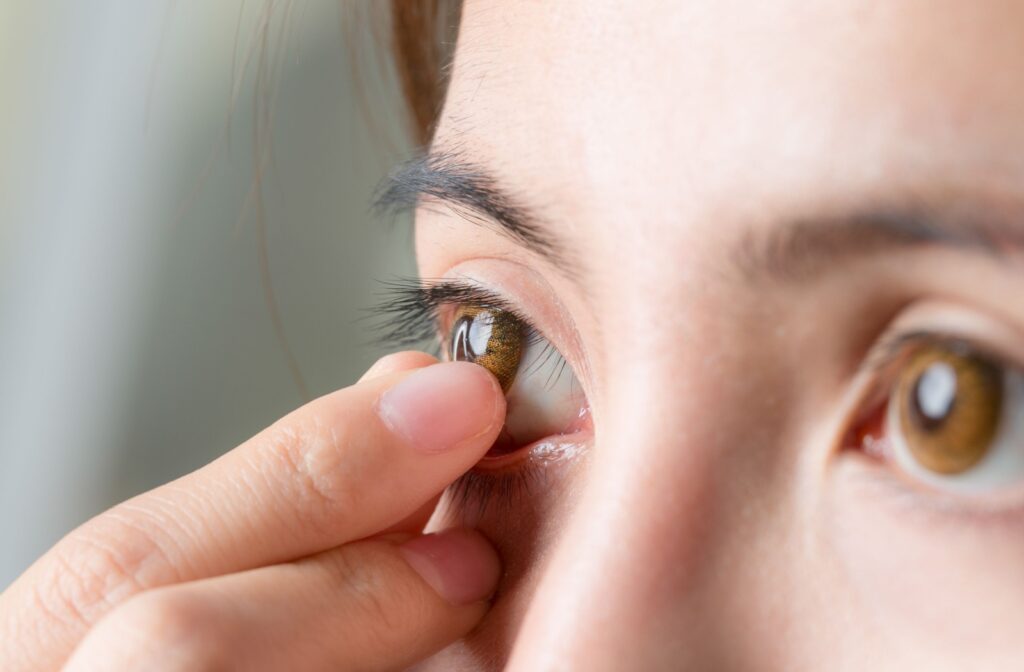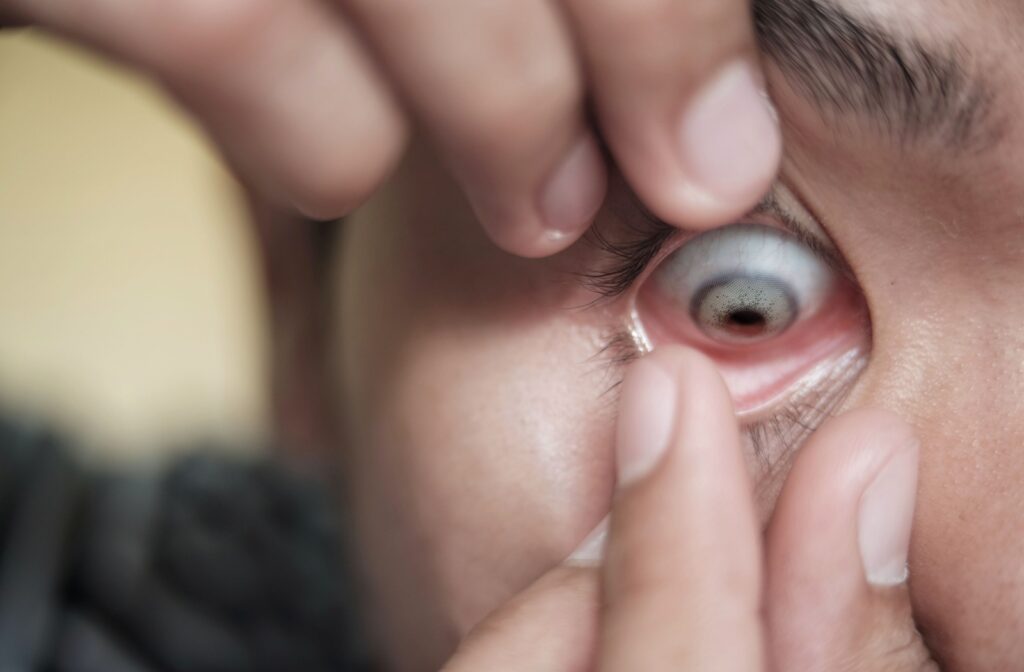Removing contact lenses might seem straightforward, but doing it correctly is crucial for your eye health and comfort. The best way to remove your contact lenses depends on the type of lens you’re using. For example, a soft contact lens typically requires only a gentle pinch, whereas a scleral or rigid gas-permeable lens may require a special suction tool.
Learning the proper removal technique prevents eye irritation, reduces your risk of infection, and helps your lenses last longer. If you’re unsure about how to insert and remove your contact lenses safely, it’s best to discuss the process with your optometrist. We can offer personalized advice based on the type of contact lenses you’re using.
Understanding Contact Lenses
The 3 main types of contact lenses are soft lenses made from flexible, water-containing plastics, rigid gas-permeable (RGP) lenses made from durable plastic that allows oxygen to pass through, and scleral lenses, which are large, rigid lenses that vault over the cornea. Each type has unique characteristics that affect how you should remove them.
How to Properly Remove Contact Lenses
Regardless of your lens type, certain preparation steps remain the same.
- Always start by washing your hands thoroughly with soap and water, then dry them with a clean, lint-free towel.
- Find a well-lit area with a clean surface.
- Keep your contact lens case nearby and filled with fresh solution if you plan to store the lenses.
- Look straight ahead into a mirror.
Removing Soft Contact Lenses
Soft contact lenses are the most forgiving type to remove.
- Start by looking up and gently pulling down your lower eyelid with your middle finger. This creates space to access the lens.
- Using your thumb and index finger, gently pinch the lens between the soft pads of your fingertips. The lens should fold slightly and come away from your eye easily. Avoid using your fingernails, which can tear the lens or scratch your eye.
- If the lens feels stuck, don’t force it. Add a few drops of rewetting drops to your eye and blink several times. This lubricates the lens and makes removal easier. Never attempt to remove a lens that feels completely stuck without contacting your eye doctor.
Removing Scleral Lenses
Scleral lenses are larger and more rigid than soft lenses, so they require a different approach. These lenses create a fluid reservoir between your lens and your eye, so you’ll need to break the seal before removing them.
The most common method uses a small plunger or suction tool specifically designed for scleral lenses:
- Wet the plunger with saline solution.
- Gently press it against the surface of your lens.
- Pull the lens straight out—don’t tilt or twist the plunger.
- Clean the plunger afterward.
Removing Rigid Gas-Permeable Contact Lenses
RGP lenses are smaller and firmer than soft lenses, making them more likely to pop out suddenly. Position yourself over a clean surface or towel to catch the lens if it falls.
The “blink method” is often the easiest method for RGP removal:
- Place your index finger at the outer corner of your eye, right at the edge of your eyelid.
- Pull the skin taut toward your ear while keeping your eyes wide open.
- Blink firmly while maintaining the skin tension.
The lens should pop out into your hand or onto the surface below. This method works because it changes the shape of your eyelid and breaks the lens’s position on your eye.
If the first attempt doesn’t work, try adjusting the position of your finger slightly up or down. Some people find that pulling the skin slightly upward is more effective than pulling straight toward the ear.

How to Know if Your Contact Lens Is Inside Out
An inside-out lens can be uncomfortable and may not stay in place properly. Soft lenses are particularly prone to flipping inside out during handling.
The easiest way to check is the “bowl test.” Place the lens on your fingertip and look at its shape from the side. A correctly oriented lens will have edges that curve inward, forming a bowl shape. An inside-out lens will have edges that flare outward.
Another method is the “taco test.” Gently squeeze the lens between your thumb and index finger. A correctly oriented lens will fold in half like a taco with the edges touching. An inside-out lens will have edges that resist touching and may form a more rigid, shell-like shape.
How to Clean Contact Lenses
Proper cleaning is essential for eye health and lens longevity.
Daily disposable lenses should never be cleaned—they’re designed for single use only. But for reusable lenses, cleaning should happen immediately after removal. This process may vary slightly depending on the lens and solution used, but proper lens cleaning typically involves these steps:
- Place the lens in your palm and add a few drops of multipurpose contact solution (never use water or saliva).
- Gently rub the lens in a back-and-forth motion for about 10 seconds. This mechanical cleaning removes protein deposits and bacteria.
- Rinse the lens thoroughly with fresh solution to remove loosened debris.
- Place the lens in a clean case filled with fresh solution.
- Replace the solution in your case every time you store your lenses
Schedule a Contact Lens Fitting
Proper contact lens removal is just one part of maintaining healthy vision. By following these techniques and maintaining good hygiene habits, you can enjoy the convenience and freedom that contact lenses provide while keeping your eyes healthy and comfortable. Contact our expert team at Tutt Street Optometry to book a contact lens exam and fitting. We can offer personalized advice on lens choice and provide direction on the proper insertion and removal of your new lenses.




